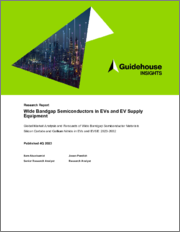
|
시장보고서
상품코드
1414757
와이드 밴드갭 반도체 시장 - 재료별, 업계별 : 세계 기회 분석 및 산업 예측(2023-2032년)Wide Bandgap Semiconductors Market By Material (Silicon Carbide, Gallium Nitride, Diamond, Others), By Industry Vertical : Global Opportunity Analysis and Industry Forecast, 2023-2032 |
||||||
와이드 밴드갭 반도체 시장의 2022년 시장 규모는 16억 달러로 평가되었고, 2023년부터 2032년까지 CAGR 13.2%로 성장할 전망이며, 2032년에는 54억 달러에 달할 것으로 예측되고 있습니다.

와이드 밴드갭 반도체로 알려진 일련의 재료는 광범위한 에너지 밴드 갭, 즉 전도대의 전자의 움직임을 수용할 수 있는 최저 에너지 밴드와 가전자대의 전자가 서식하는 최고 에너지 밴드 사이의 에너지 차이를 있습니다. 이러한 재료는 밴드갭이 좁은 실리콘과 같은 기존의 반도체와 달리 밴드갭이 넓습니다.
고성능, 에너지 효율적인 전자기기에 대한 요구는 와이드 밴드갭 반도체 산업에서 혁명적인 발전을 촉진하고 있습니다. 기술 혁신의 선진을 끊고 있는 것은 탄화규소(SiC)와 질화갈륨(GaN)이며, 파워 일렉트로닉스, 전기 자동차, 5G 인프라, 재생가능 에너지 및 시스템 등에서 이용되고 있습니다. 전 세계적으로 산업계가 지속가능성과 효율성을 강조함에 따라 와이드 밴드갭 반도체의 인기가 높아지고 있습니다. 현재의 동향에는 기술 통합을 촉진하는 파트너십, 수율 향상을 위한 제조 기술 개선, 현대 전자 분야를 변화시키는 이러한 반도체의 모든 잠재력을 실현하기 위한 끊임없는 노력이 포함됩니다.
질화갈륨(GaN)과 탄화규소(SiC)는 일반적인 광대역 갭 반도체 재료입니다. 이 재료는 밴드갭이 크므로 높은 온도와 전압에서 작동할 수 있으며 고출력 및 고주파 전자 장치가 필요한 용도에 적합합니다. 광대역 갭 반도체의 용도는 파워 일렉트로닉스, 고주파(RF) 장비, LED 조명, 전기 자동차, 재생가능 에너지원 등을 포함합니다. 와이드 밴드갭 반도체의 특별한 특성은 여러 응용 분야에서 더 나은 성능, 더 높은 에너지 효율 및 기술적 성장을 지원합니다.
와이드 밴드갭 반도체 시장은 재료, 용도, 배터리 유형, 지역으로 구분됩니다. 재료별로는 탄화규소(SiC), 질화갈륨(GaN), 다이아몬드 등으로 분류됩니다. 업계별로는 가전, 자동차, 항공우주 및 방위, IT 및 통신, 에너지 및 유틸리티 등으로 분류됩니다. 지역별로 북미, 유럽, 아시아태평양, LAMEA 및 주요 국가에 대해 분석됩니다.
지역별로는 북미(미국, 캐나다, 멕시코), 유럽(영국, 독일, 프랑스, 기타 유럽), 아시아태평양(중국, 일본, 인도, 한국, 기타 아시아태평양), LAMEA(중남미, 중동· 아프리카)에서 와이드 밴드갭 반도체 시장 동향을 분석했습니다.
이 보고서에서 제공하는 세계 주요 와이드 밴드갭 반도체 시장 기업의 경쟁 분석 및 프로파일은 Infineon Technologies AG, Microsemi Corporation, ST Microelectronics, Maxell Ltd., Rome Semiconductor, Texas Instruments Inc., Vishay Intertechnology Inc., 파나소닉 주식 회사, Genesic semiconductor, Nexperia, Wolfspeed, Inc. 등이 포함됩니다. 와이드 밴드갭 반도체 시장의 주요 기업이 채택하는 주요 전략은 제품 출시입니다.
목차
제1장 서론
제2장 주요 요약
제3장 시장 개요
- 시장 정의 및 범위
- 주요 조사 결과
- 영향 요인
- 주요 투자 기회
- Porter's Five Forces 분석
- 시장 역학
- 성장 촉진요인
- 와이드 밴드갭 재료의 연구 개발 활동에 대한 투자 확대
- EV 수요의 급증이 세계 와이드 밴드갭 반도체 시장 견인
- 억제요인
- 와이드 밴드갭 반도체의 고비용
- 기회
- 전기 자동차의 와이드 밴드갭 디바이스 수요 증가
- 성장 촉진요인
제4장 와이드 밴드갭 반도체 시장 : 재료별
- 개요
- 탄화규소(SiC)
- 질화갈륨(GaN)
- 다이아몬드
- 기타
제5장 와이드 밴드갭 반도체 시장 : 업계별
- 개요
- 소비자 일렉트로닉스
- 자동차
- 항공우주 및 방위
- IT 및 통신
- 에너지 및 유틸리티
- 기타
제6장 와이드 밴드갭 반도체 시장 : 지역별
- 개요
- 북미
- 미국
- 캐나다
- 멕시코
- 아시아태평양
- 중국
- 일본
- 인도
- 한국
- 기타
- 유럽
- 영국
- 독일
- 프랑스
- 기타
- 라틴아메리카
- 라틴아메리카
- 중동
- 아프리카
제7장 경쟁 구도
- 서문
- 주요 성공 전략
- 주요 10개사의 제품 매핑
- 경쟁 대시보드
- 경쟁 히트맵
- 주요 기업의 포지셔닝(2022년)
제8장 기업 프로파일
- Infineon Technologies AG
- Microsemi Corporation.
- STMicroelectronics
- ROHM Semiconductor
- Texas Instruments Inc.
- Vishay Intertechnology Inc.
- Genesic Semiconductor
- Panasonic Corporation
- Nexperia
- Wolfspeed, Inc.
According to a new report published by Allied Market Research, titled, "Wide Bandgap Semiconductors Market," The wide bandgap semiconductors market was valued at $1.6 billion in 2022, and is estimated to reach $5.4 billion by 2032, growing at a CAGR of 13.2% from 2023 to 2032.

The range of materials known as wide bandgap semiconductors have a broad energy bandgap, or the energy difference between the lowest energy band that can accommodate electron movement in the conduction band and the highest energy band that is inhabited by electrons in the valence band. These materials differ from conventional semiconductors like silicon, which have narrower bandgaps, in that they have a broad bandgap.
The need for high-performance and energy-efficient electronic devices is driving revolutionary developments in the wide bandgap semiconductor industry. At the vanguard of innovation are silicon carbide (SiC) and gallium nitride (GaN), which have several uses in power electronics, electric cars, 5G infrastructure, and renewable energy systems. Around the world, wide bandgap semiconductors are becoming more and more popular as industries place a higher priority on sustainability and efficiency. The current trends include partnerships that promote technological integration, improvements in manufacturing techniques for increased yields, and a persistent drive to realise the whole potential of these semiconductors in transforming the field of contemporary electronics.
Gallium nitride (GaN) and silicon carbide (SiC) are common wide bandgap semiconductor materials. These materials are appropriate for applications that call for high-power and high-frequency electronic devices because of their larger bandgap, which allows them to function at greater temperatures and voltages. Applications for wide bandgap semiconductors include power electronics, radiofrequency (RF) equipment, LED lighting, electric cars, and renewable energy sources. Their special qualities support better performance, more energy efficiency, and technological growth in several application areas.
The wide bandgap semiconductor market is segmented into material, application, battery type, and region. By material, the market is classified into silicon carbide (SiC), gallium nitride (GaN), diamond, and others. By industry vertical, it is bifurcated into consumer electronics, automotive, aerospace and defense, IT and telecom, energy and utility, and others. Region wise, the market is analyzed across North America, Europe, Asia-Pacific, and LAMEA along with their prominent countries.
Region wise, the wide bandgap semiconductor market trends are analyzed across North America (the U.S., Canada, and Mexico), Europe (the UK, Germany, France, and rest of Europe), Asia-Pacific (China, Japan, India, South Korea, and rest of Asia-Pacific), and LAMEA (Latin America, the Middle East, and Africa).
Competitive analysis and profiles of the major global wide bandgap semiconductor market players that have been provided in the report include Infineon Technologies AG, Microsemi Corporation, STMicroelectronics, Maxell Ltd., ROHM Semiconductor, Texas Instruments Inc., Vishay Intertechnology Inc., Panasonic Corporation, Genesic semiconductor, Nexperia and Wolfspeed, Inc. The key strategies adopted by the major players of the wide bandgap semiconductor market are product launch.
Key Benefits For Stakeholders
- This report provides a quantitative analysis of the market segments, current trends, estimations, and dynamics of the wide bandgap semiconductors market analysis from 2022 to 2032 to identify the prevailing wide bandgap semiconductors market opportunities.
- The market research is offered along with information related to key drivers, restraints, and opportunities.
- Porter's five forces analysis highlights the potency of buyers and suppliers to enable stakeholders make profit-oriented business decisions and strengthen their supplier-buyer network.
- In-depth analysis of the wide bandgap semiconductors market segmentation assists to determine the prevailing market opportunities.
- Major countries in each region are mapped according to their revenue contribution to the global market.
- Market player positioning facilitates benchmarking and provides a clear understanding of the present position of the market players.
- The report includes the analysis of the regional as well as global wide bandgap semiconductors market trends, key players, market segments, application areas, and market growth strategies.
Additional benefits you will get with this purchase are:
- Quarterly Update and* (only available with a corporate license, on listed price)
- 5 additional Company Profile of client Choice pre- or Post-purchase, as a free update.
- Free Upcoming Version on the Purchase of Five and Enterprise User License.
- 16 analyst hours of support* (post-purchase, if you find additional data requirements upon review of the report, you may receive support amounting to 16 analyst hours to solve questions, and post-sale queries)
- 15% Free Customization* (in case the scope or segment of the report does not match your requirements, 15% is equivalent to 3 working days of free work, applicable once)
- Free data Pack on the Five and Enterprise User License. (Excel version of the report)
- Free Updated report if the report is 6-12 months old or older.
- 24-hour priority response*
- Free Industry updates and white papers.
Possible Customization with this report (with additional cost and timeline, please talk to the sales executive to know more)
- Product Benchmarking / Product specification and applications
- New Product Development/ Product Matrix of Key Players
- Regulatory Guidelines
- Import Export Analysis/Data
Key Market Segments
By Material
- Gallium Nitride (GaN)
- Diamond
- Others
- Silicon Carbide (SiC)
By Industry Vertical
- Consumer Electronics
- Automotive
- Aerospace and Defense
- IT and Telecom
- Energy and Utility
- Others
By Region
- North America
- U.S.
- Canada
- Mexico
- Asia-Pacific
- China
- Japan
- India
- South Korea
- Rest of Asia-Pacific
- Europe
- UK
- Germany
- France
- Rest of Europe
- LAMEA
- Latin America
- Middle East
- Africa
Key Market Players:
- Infineon Technologies AG
- STMicroelectronics
- ROHM Semiconductor
- Vishay Intertechnology Inc.
- Nexperia
- Genesic Semiconductor
- Wolfspeed, Inc.
- Microsemi Corporation.
- Texas Instruments Inc.
- Panasonic Corporation
TABLE OF CONTENTS
CHAPTER 1: INTRODUCTION
- 1.1. Report description
- 1.2. Key market segments
- 1.3. Key benefits to the stakeholders
- 1.4. Research methodology
- 1.4.1. Primary research
- 1.4.2. Secondary research
- 1.4.3. Analyst tools and models
CHAPTER 2: EXECUTIVE SUMMARY
- 2.1. CXO Perspective
CHAPTER 3: MARKET OVERVIEW
- 3.1. Market definition and scope
- 3.2. Key findings
- 3.2.1. Top impacting factors
- 3.2.2. Top investment pockets
- 3.3. Porter's five forces analysis
- 3.3.1. High bargaining power of suppliers
- 3.3.2. Moderate threat of new entrants
- 3.3.3. Low to moderate threat of substitutes
- 3.3.4. Moderate to high intensity of rivalry
- 3.3.5. Moderate to high bargaining power of buyers
- 3.4. Market dynamics
- 3.4.1. Drivers
- 3.4.1.1. Growing investments in R&D activities for wide bandgap materials
- 3.4.1.2. Surge in demand for EVs driving global wide band gap semiconductors market
- 3.4.2. Restraints
- 3.4.2.1. High cost of wide bandgap semiconductor
- 3.4.3. Opportunities
- 3.4.3.1. Growing demand for wide bandgap devices in electric vehicles
- 3.4.1. Drivers
CHAPTER 4: WIDE BANDGAP SEMICONDUCTORS MARKET, BY MATERIAL
- 4.1. Overview
- 4.1.1. Market size and forecast
- 4.2. Silicon Carbide (SiC)
- 4.2.1. Key market trends, growth factors and opportunities
- 4.2.2. Market size and forecast, by region
- 4.2.3. Market share analysis by country
- 4.3. Gallium Nitride (GaN)
- 4.3.1. Key market trends, growth factors and opportunities
- 4.3.2. Market size and forecast, by region
- 4.3.3. Market share analysis by country
- 4.4. Diamond
- 4.4.1. Key market trends, growth factors and opportunities
- 4.4.2. Market size and forecast, by region
- 4.4.3. Market share analysis by country
- 4.5. Others
- 4.5.1. Key market trends, growth factors and opportunities
- 4.5.2. Market size and forecast, by region
- 4.5.3. Market share analysis by country
CHAPTER 5: WIDE BANDGAP SEMICONDUCTORS MARKET, BY INDUSTRY VERTICAL
- 5.1. Overview
- 5.1.1. Market size and forecast
- 5.2. Consumer Electronics
- 5.2.1. Key market trends, growth factors and opportunities
- 5.2.2. Market size and forecast, by region
- 5.2.3. Market share analysis by country
- 5.3. Automotive
- 5.3.1. Key market trends, growth factors and opportunities
- 5.3.2. Market size and forecast, by region
- 5.3.3. Market share analysis by country
- 5.4. Aerospace and Defense
- 5.4.1. Key market trends, growth factors and opportunities
- 5.4.2. Market size and forecast, by region
- 5.4.3. Market share analysis by country
- 5.5. IT and Telecom
- 5.5.1. Key market trends, growth factors and opportunities
- 5.5.2. Market size and forecast, by region
- 5.5.3. Market share analysis by country
- 5.6. Energy and Utility
- 5.6.1. Key market trends, growth factors and opportunities
- 5.6.2. Market size and forecast, by region
- 5.6.3. Market share analysis by country
- 5.7. Others
- 5.7.1. Key market trends, growth factors and opportunities
- 5.7.2. Market size and forecast, by region
- 5.7.3. Market share analysis by country
CHAPTER 6: WIDE BANDGAP SEMICONDUCTORS MARKET, BY REGION
- 6.1. Overview
- 6.1.1. Market size and forecast By Region
- 6.2. North America
- 6.2.1. Key market trends, growth factors and opportunities
- 6.2.2. Market size and forecast, by Material
- 6.2.3. Market size and forecast, by Industry Vertical
- 6.2.4. Market size and forecast, by country
- 6.2.4.1. U.S.
- 6.2.4.1.1. Market size and forecast, by Material
- 6.2.4.1.2. Market size and forecast, by Industry Vertical
- 6.2.4.2. Canada
- 6.2.4.2.1. Market size and forecast, by Material
- 6.2.4.2.2. Market size and forecast, by Industry Vertical
- 6.2.4.3. Mexico
- 6.2.4.3.1. Market size and forecast, by Material
- 6.2.4.3.2. Market size and forecast, by Industry Vertical
- 6.3. Asia-Pacific
- 6.3.1. Key market trends, growth factors and opportunities
- 6.3.2. Market size and forecast, by Material
- 6.3.3. Market size and forecast, by Industry Vertical
- 6.3.4. Market size and forecast, by country
- 6.3.4.1. China
- 6.3.4.1.1. Market size and forecast, by Material
- 6.3.4.1.2. Market size and forecast, by Industry Vertical
- 6.3.4.2. Japan
- 6.3.4.2.1. Market size and forecast, by Material
- 6.3.4.2.2. Market size and forecast, by Industry Vertical
- 6.3.4.3. India
- 6.3.4.3.1. Market size and forecast, by Material
- 6.3.4.3.2. Market size and forecast, by Industry Vertical
- 6.3.4.4. South Korea
- 6.3.4.4.1. Market size and forecast, by Material
- 6.3.4.4.2. Market size and forecast, by Industry Vertical
- 6.3.4.5. Rest of Asia-Pacific
- 6.3.4.5.1. Market size and forecast, by Material
- 6.3.4.5.2. Market size and forecast, by Industry Vertical
- 6.4. Europe
- 6.4.1. Key market trends, growth factors and opportunities
- 6.4.2. Market size and forecast, by Material
- 6.4.3. Market size and forecast, by Industry Vertical
- 6.4.4. Market size and forecast, by country
- 6.4.4.1. UK
- 6.4.4.1.1. Market size and forecast, by Material
- 6.4.4.1.2. Market size and forecast, by Industry Vertical
- 6.4.4.2. Germany
- 6.4.4.2.1. Market size and forecast, by Material
- 6.4.4.2.2. Market size and forecast, by Industry Vertical
- 6.4.4.3. France
- 6.4.4.3.1. Market size and forecast, by Material
- 6.4.4.3.2. Market size and forecast, by Industry Vertical
- 6.4.4.4. Rest of Europe
- 6.4.4.4.1. Market size and forecast, by Material
- 6.4.4.4.2. Market size and forecast, by Industry Vertical
- 6.5. LAMEA
- 6.5.1. Key market trends, growth factors and opportunities
- 6.5.2. Market size and forecast, by Material
- 6.5.3. Market size and forecast, by Industry Vertical
- 6.5.4. Market size and forecast, by country
- 6.5.4.1. Latin America
- 6.5.4.1.1. Market size and forecast, by Material
- 6.5.4.1.2. Market size and forecast, by Industry Vertical
- 6.5.4.2. Middle East
- 6.5.4.2.1. Market size and forecast, by Material
- 6.5.4.2.2. Market size and forecast, by Industry Vertical
- 6.5.4.3. Africa
- 6.5.4.3.1. Market size and forecast, by Material
- 6.5.4.3.2. Market size and forecast, by Industry Vertical
CHAPTER 7: COMPETITIVE LANDSCAPE
- 7.1. Introduction
- 7.2. Top winning strategies
- 7.3. Product mapping of top 10 player
- 7.4. Competitive dashboard
- 7.5. Competitive heatmap
- 7.6. Top player positioning, 2022
CHAPTER 8: COMPANY PROFILES
- 8.1. Infineon Technologies AG
- 8.1.1. Company overview
- 8.1.2. Key executives
- 8.1.3. Company snapshot
- 8.1.4. Operating business segments
- 8.1.5. Product portfolio
- 8.1.6. Business performance
- 8.1.7. Key strategic moves and developments
- 8.2. Microsemi Corporation.
- 8.2.1. Company overview
- 8.2.2. Key executives
- 8.2.3. Company snapshot
- 8.2.4. Operating business segments
- 8.2.5. Product portfolio
- 8.2.6. Business performance
- 8.3. STMicroelectronics
- 8.3.1. Company overview
- 8.3.2. Key executives
- 8.3.3. Company snapshot
- 8.3.4. Operating business segments
- 8.3.5. Product portfolio
- 8.3.6. Business performance
- 8.3.7. Key strategic moves and developments
- 8.4. ROHM Semiconductor
- 8.4.1. Company overview
- 8.4.2. Key executives
- 8.4.3. Company snapshot
- 8.4.4. Operating business segments
- 8.4.5. Product portfolio
- 8.4.6. Business performance
- 8.4.7. Key strategic moves and developments
- 8.5. Texas Instruments Inc.
- 8.5.1. Company overview
- 8.5.2. Key executives
- 8.5.3. Company snapshot
- 8.5.4. Operating business segments
- 8.5.5. Product portfolio
- 8.5.6. Business performance
- 8.5.7. Key strategic moves and developments
- 8.6. Vishay Intertechnology Inc.
- 8.6.1. Company overview
- 8.6.2. Key executives
- 8.6.3. Company snapshot
- 8.6.4. Operating business segments
- 8.6.5. Product portfolio
- 8.6.6. Business performance
- 8.7. Genesic Semiconductor
- 8.7.1. Company overview
- 8.7.2. Key executives
- 8.7.3. Company snapshot
- 8.7.4. Operating business segments
- 8.7.5. Product portfolio
- 8.8. Panasonic Corporation
- 8.8.1. Company overview
- 8.8.2. Key executives
- 8.8.3. Company snapshot
- 8.8.4. Operating business segments
- 8.8.5. Product portfolio
- 8.8.6. Business performance
- 8.9. Nexperia
- 8.9.1. Company overview
- 8.9.2. Key executives
- 8.9.3. Company snapshot
- 8.9.4. Operating business segments
- 8.9.5. Product portfolio
- 8.9.6. Key strategic moves and developments
- 8.10. Wolfspeed, Inc.
- 8.10.1. Company overview
- 8.10.2. Key executives
- 8.10.3. Company snapshot
- 8.10.4. Operating business segments
- 8.10.5. Product portfolio
- 8.10.6. Business performance
- 8.10.7. Key strategic moves and developments














